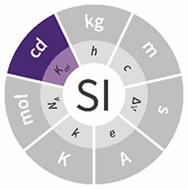Luminous Intensity (the candela, cd)
SI base unit of luminous intensity
Current Definition
The candela, symbol cd, is the SI unit of luminous intensity in a given direction. It is defined by taking the fixed numerical value of the luminous efficacy of monochromatic radiation of frequency 540 x 1012 Hz, Kcd, to be 683 when expressed in the unit lm W−1 , which is equal to cd sr W−1 , or cd sr kg−1 m−2 s 3 , where the kilogram, metre and second are defined in terms of h, c and ΔvCs.

History
| Year | Definition of the candela |
|---|---|
| Before 1948 | The unit of luminous intensity was defined based on flame or incandescent filament standards in use in various countries. |
| 1948 | The candela, or the so called 'the new candle', was defined based on the luminance of a Planck radiator (a blackbody) at the temperature of freezing platinum. |
| 1979 | Due to the difficulties in realizing a Planck radiator at high temperatures and the advancement in radiometry, the candela was redefined as follows based on the measurement of optical radiation power. "The candela is the luminous intensity, in a given direction, of a source that emits monochromatic radiation of frequency 540 x 1012 hertz and that has a radiant intensity in that direction of 1/683 watt per steradian." |
| 2019 | The definition of candela was redefined to establish the base units in terms of a defining constant, the luminous efficacy of monochromatic radiation of frequency 540 x 1012 Hz, Kcd. This is a technical constant that gives an exact numerical relationship between the purely physical characteristics of the radiant power stimulating the human eye (W) and its photobiological response defined by the luminous flux due to the spectral responsivity of a standard observer (lm) at a frequency of 540 x 1012 hertz. |
Reference
- The International System of Units (SI) – Base Unit
- The ninth SI Brochure